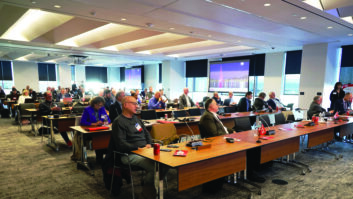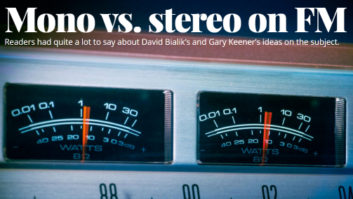This article originally appeared on sister publication TWICE.
We may not realize it, but digital audio technology is one of our closest companions.
Do you listen to music, podcasts, and watch TV or movies on your smartphone? These days, audio and video entertainment are immediately accessible at any time of the day or night, whether we are at home, at work, or on the go.
While the luxury of a personalized, portable, “always on” digital audio experience is taken for granted today, it is a relatively recent phenomenon. Join me as we travel back in time to trace the fascinating evolution of audio, before gazing into the future for a glimpse of the acoustic innovations awaiting our ears.
It was long thought that Thomas Edison’s 1878 recording of “Mary Had a Little Lamb” was the earliest to capture the human voice, but a recently-discovered recording made by Frenchman Édouard-Léon Scott de Martinville of a verse from the French folk song “Au Clair de la Lune” predates Edison’s recording by 17 years. De Martinville made the 20-second recording using his own invention, the Phonautograph, which transcribed sound waves but could not play them back.
Edison’s Phonograph went a step further than the Phonautograph, recording sound onto a tin foil-wrapped cylinder that could be played back. Emile Berliner further improved the process by inventing the Gramophone, which could play discs rather than cylinders. The disc went on to become the standard medium for sound recording, dominating the audio market until the end of the 20th century.
Listening to old recordings, one gets an imperfect sense of the allure and power of the human voice. Audio technology of the time was not only monaural (or “mono”) but also low-fidelity. While mono recording can be suitable for speech, it does not do justice to the depth and breadth of music and other sound.
Nonetheless, monaural recording was revolutionary for its time. Imagine living in the early 20th century — all films were silent, with dialogue conveyed through gestures and title cards. “The Jazz Singer,” the first “talkie,” debuted in the U.S. in 1927. Not surprisingly, moviegoers liked what they heard, and suddenly the entire movie industry needed audio equipment. Seeking to improve talking film technology, Douglas Shearer of MGM Studios and James B. Lansing, the future founder of JBL, created a system of horn-shaped speakers so effective that they received an Academy Award.
In 1931, English electronics engineer Alan Blumlein came home from a movie, frustrated that the sound on screen could only be heard from a speaker across the room. In response, he invented the audio stereo system still in use today. By seeking to re-create the multi-directional features of the sound field, Blumlein’s stereophonic sound provided a sense of relative space—and allowed music to at last sound as it should.
Jumping to the 1940s, artists like Les Paul began experimenting with multi-track recordings, paving the way for the development of 4- and 8-tracks. In 1953, AKG invented the world’s first dynamic cardioid microphone, the D12, whose sonic qualities propelled it into radio stations, theaters and recording studios, setting the standard for voice transmissions at the time. Its successor, the D19, was famously used at Abbey Road Studios during many of The Beatles’ recording sessions.
The eight-track gave way to the compact cassette, whose commercial breakthrough came in the mid-1960s. Based on magnetic tape recording technology invented in 1930, the cassette went on to become a fiercely popular format. Constant improvements in quality, as well as innovations such as the portable cassette player, meant cassette tapes could be enjoyed everywhere—and indeed they were.
The 1980s marked a paradigm shift in the audio world with the arrival of the Compact Disc, which used optical laser technology to record and reproduce digital audio signals. A mere three years after the first titles were released in 1982, one million CD players had been sold. The first portable devices quickly followed, as well as the first car radio with integrated CD player, released by the German audio company Becker in 1985.
With the replacement of analog recording by digital recording in the music industry, digital signal processing (DSP) took off. Advances in microelectronics made it possible to manipulate the signals of a digital recording in a variety of ways, including filtering out unwanted noise, compressing the signal for faster transmission, and creating effects to shape and enhance the sound of music. Built-in DSP for electronic devices grew in popularity and affordability, leading to a breakthrough in sound feature development and quality, even in the car. Released in 1997, the Becker Energy 350 was the first combination digital/DSP car amplifier.
A new digital audio milestone came in the 1990s with the MPEG audio layer III format, or MP3. Born of a common desire within the industry for audio encoding standards, the MP3 compressed digital audio files for easy high-quality transfer. While not an immediate hit, the growth of the Internet provided a springboard for the MP3, ultimately establishing it as the undisputed standard for online music, from downloading to file sharing to the latest form of music consumption: streaming.
After this simply incredible evolution, what’s in store for the future of audio? Enjoying digital sound files via smart connectivity technologies such as Bluetooth and Wi-Fi is the new norm. As we move forward, you will see even more smart audio solutions, such as virtual assistants featuring AI and voice control technology, in-car audio systems that provide individual sound zones and conferencing capabilities, and autonomous vehicles equipped with voice-controlled digital assistants, car-to-home IoT functionality, virtual and augmented reality and much, much more. The audio experience awaiting us is certain to be ever more connected, ever more intuitive, and ever more immersive.
As the sonic landscape has transitioned from mono to stereo to smart, one thing has remained the same: the ability of recorded sound to take our breath away. Since 1877, it has never ceased to surprise us—and it never will.
Michael Mauser is regional head of Harman Europe and executive VP and president of the Lifestyle Audio division, which develops, manufactures and sells car audio solutions, as well as consumer audio products for the home and on the go. He oversees an organization of more than 6,500 employees with engineering, manufacturing, sales and marketing centers around the globe.











